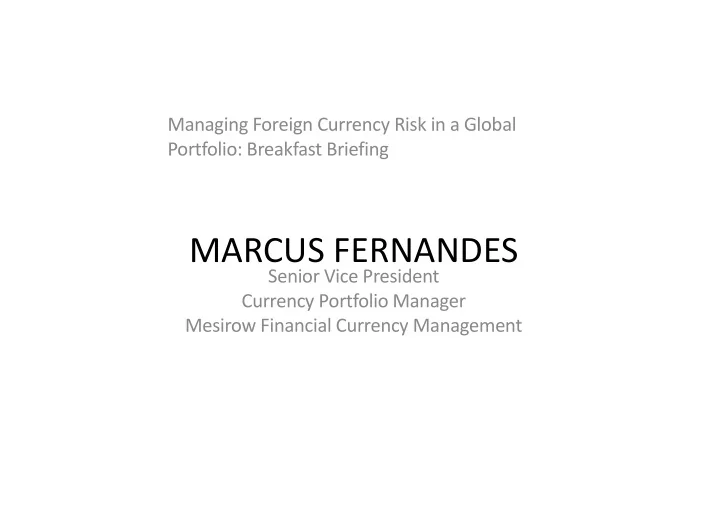

Managing Foreign Currency Risk in a Global Portfolio: Breakfast Briefing MARCUS FERNANDES Senior Vice President Currency Portfolio Manager Mesirow Financial Currency Management
Currency Risks and Opportunities ‐ Overview • Context for Euro ‐ based investors • Current market drivers • Risk management considerations • Regulatory Update
EUR vs USD EURUSD 1.7 1.6 1.5 1.4 1.3 1.2 1.1 1 0.9 Source: Bloomberg 0.8
EUR vs GBP EURGBP 1 0.9 0.8 0.7 Source: Bloomberg 0.6
Central bank policy 7 6 5 4 BoE ECB Fed 3 2 Source: Bloomberg 1 0
Other near ‐ term drivers • US election outcome and implications for US economy • Speed of structural divergence in global rates • Article 50 clarification and timing • China economic growth
The quick basics • At its simplest, currency hedging involves locking in the future exchange rate at which you can sell foreign assets and bring the money home into EUR • With the future rate set, you aim to protect yourself from exchange rate fluctuations • When the value of EUR rises, you want to be hedged • When the value of EUR falls, you want to be unhedged
Risk management considerations • Currency interaction with the wider portfolio – Underlying Asset Classes • Equities • Fixed Income • Illiquid Investments • Emerging Markets
Currency risk management approaches Unhedged position (Do Nothing) • – Currency risk not significant to the overall portfolio – Diversification benefits of unhedged position Passive Risk Management • – Manage unwanted volatility, take advantage of long term structural bias Active Risk Management • – Add to returns, adapt to changes, provide downside risk protection
Passive example MSCI World (Local) MSCI World (EUR) MSCI World (100% EUR Hedged) 100.00% 80.00% 60.00% 40.00% 20.00% 0.00% ‐ 20.00% ‐ 40.00% Source: Bloomberg ‐ 60.00% ‐ 80.00%
A quick active tour: Value, Trend & Carry EURUSD 1.7 1.6 1.5 1.4 1.3 1.2 1.1 1 0.9 Source: Bloomberg 0.8
The market, upcoming regulatory reform The FX market is still the biggest market in town • – Average daily turnover: $5.1 trillion per day – Slightly smaller in size than 3 years ago – Less speculation, more hedging – Staffing levels on trading desks are smaller due to a combination of less speculation and more technology FX forwards in Europe (EMIR) will need to be collateralised • – Currently March 2017 MiFid II reporting is on the way and FX forwards will be a part of this as we push • toward greater regulatory oversight, Currency managers will have to demonstrate their commitment to transparency
Final Thoughts • Currency Wars • The risk of competitive devaluations • Volatility
Recommend
More recommend